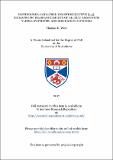Isothiourea-catalysed enantioselective [2,3]-sigmatropic rearrangements of allylic ammonium ylides : synthetic and mechanistic studies
Abstract
The research in this thesis describes the development of an isothiourea-catalysed enantioselective [2,3]-rearrangement of allylic ammonium ylides, subsequent mechanistic and collaborative computational
studies and the its application to the enantioselective synthesis of free α-amino esters.
Chapter 1 aims to place this work in the context of the previous literature, highlighting a range of
stereoselective [2,3]-rearrangements of allylic ammonium ylides. Examples of catalytic stereoselective
[2,3]-rearrangement of allylic ammonium ylides as well as state-of-the-art examples of organocatalytic
enantioselective variants of the related [2,3]-Wittig rearrangement are discussed. The aims of this
research project are also set out.
Chapter 2 describes the discovery and optimisation of the isothiourea-catalysed [2,3]-rearrangement of
4-nitrophenyl ester quaternary ammonium salts (either isolated or generated in situ) to give a range of
syn-α-amino acid derivatives in excellent yields (33-89%) and stereocontrol (up to >95:5 dr and >99%
ee). This represents the first catalytic enantioselective variant of a [2,3]-rearrangement of allylic
ammonium ylides.
Chapter 3 describes mechanistic studies. Reaction kinetic analysis by ¹⁹F NMR has allowed reaction
profiles to be built up, orders of each component to be determined and catalyst resting state to be probed.
A catalytic intermediate has been observed; its constitution was proved unambiguously by
¹³C and ¹⁵N isotopic labelling. Isotopic entrainment has proved the observed intermediate to be on-cycle and
productive towards catalysis. Competition kinetic isotope effects have provided detailed insight into the
[2,3]-rearrangement step of the process. The effect of HOBt upon stereocontrol and the resting state of
the catalyst have been probed through in situ
¹⁹F NMR. Crossover experiments have given detailed
insight into the reversibility of each of the proposed catalytic steps. Collaborative computational work
has elucidated the origins of stereocontrol and has supported the experimentally proposed mechanism.
Chapter 4 describes the application of this methodology to the enantioselective synthesis of free α-amino esters via [2,3]-rearrangement of N,N-diallyl allylic ammonium ylides. Enantio- and
chemoselective [2,3]-rearrangement gave a range of N,N-diallyl α-amino esters, which could be readily
selectively mono- or bis-N-allyl deprotected. Bis-N-allyl deprotection gave a range of enantioenriched
free α-amino esters. Selective mono-N-allyl deprotection was employed in the synthesis of a
functionalised piperidine motif.
Chapter 5 summarises the work outlined in this thesis and draws conclusions, as well as giving insight
into potential future projects within the area.
Type
Thesis, PhD Doctor of Philosophy
Collections
Items in the St Andrews Research Repository are protected by copyright, with all rights reserved, unless otherwise indicated.

